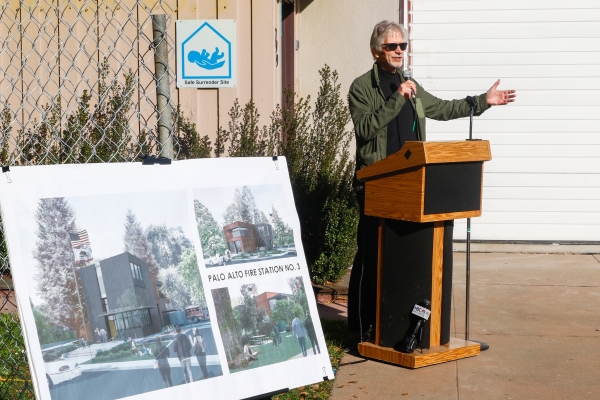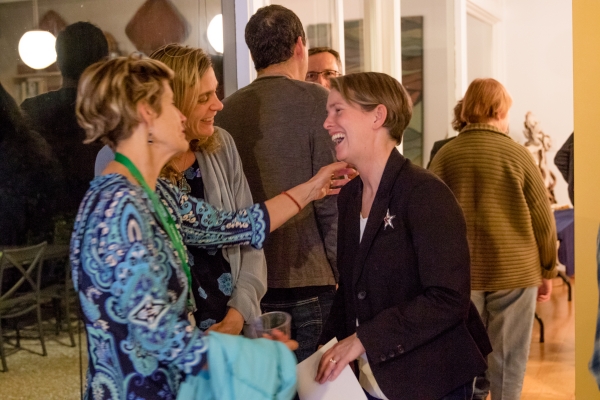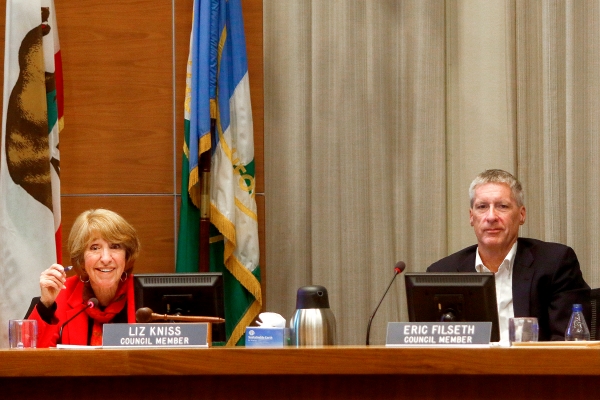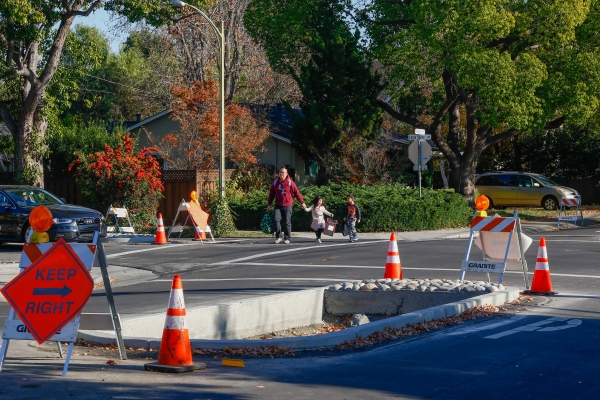During his decade as Palo Alto's city manager, James Keene personally witnessed how radically and rapidly local politics can shift.
He was here in 2013, when residents staged a referendum to overturn a housing development that the City Council had unanimously approved; in 2014 for the election when slow-growth "residentialists" won the council majority; and in 2016, when the candidates favoring more city growth took back the power.
When the soon-to-retire Keene addressed the council on Dec. 17, his final meeting in City Hall's most critical position, he mused about the delicate nature of democracy and lamented the divisiveness in Washington, D.C., and elsewhere in the world.
"There is emergent polarization here," Keene warned. "The defining nature of polarization isn't one-sidedness — you don't have polarization with just one dimension. In a sense, we're all responsible."
Division in the community was certainly on display in Palo Alto in 2018, particularly over issues like rent control, the Ross Road bike project and commercial growth. Yet it may offer some gratification to Keene — a Buddhist who is described in the city's official resolution of appreciation as, among other things, a "bodhisattva" — that in his final year in charge, Palo Alto moved decidedly toward the middle path. While the political divisions of yesteryear never dissolved, 2018 was by and large a period of compromise and moderation — a year that taught us that when it comes to politics, the center can indeed hold.
That message was sounded early in the year, when the City Council elevated its most centrist member — Eric Filseth — to the vice mayor's chair, setting him up for mayorship in 2019. And it resounded in November, when Palo Alto voters elected a moderate challenger with no strong political affiliations over a staunchly pro-growth incumbent. Along the way, the council eliminated from consideration its most extreme (and expensive) options for separating the railroad tracks from the roadways; reduced the long-term limit on office development to a level that matches recent history; and unanimously selected Assistant City Manager Ed Shikada — an experienced engineer and policy maker — as its next city manager. It began to make slow and gradual progress on the ever-critical topic of housing; and it began implementing the policies of its new Comprehensive Plan — a document that was completed in the end of 2017 and that, true to its name, gave just about everyone something to praise and complain about.
'Crisis mode'
Palo Alto's elected leaders were surely over-optimistic when they adopted in early February a goal of adding 300 residences per year for the next 15 years. That number was based on the council's new Comprehensive Plan, which envisions construction of between 3,500 and 4,400 new housing units in the city by 2030.
Mayor Liz Kniss, and Councilmen Adrian Fine and Cory Wolbach, who had all made housing the central issue of their respective campaigns in prior years, talked about the ongoing housing crisis with a sense of urgency and submitted a memo in late 2017 proposing a series of zone changes to spur more residential construction. In a rare show of bipartisanship, the full council embraced the memo.
During the February retreat, Kniss encouraged residents to think about the impacts of the city's severe housing shortage and to consider questions such as: Would I like my kids to live here? Would I like to stay here as long as possible? She also said she was optimistic that the council could achieve its goal of 300 apartments, condominiums and other residences.
"It's daunting somewhat, but I believe we can do it," Kniss said.
Yet by the end of the year, Keene was forced to acknowledge the city had fallen far short of its adopted goal. Despite making housing a top priority, the council only approved one multi-family development this year, a 57-apartment complex at the corner of El Camino Real and Page Mill Road for the city's "missing middle" — residents who make too much to qualify for below-market-rate housing but not enough to afford the typical market-rate apartment.
• CHART: See more data surrounding housing, the school district and other sectors in Palo Alto by reviewing "The Year in Numbers."
Things, however, aren't completely bleak for housing advocates. The city's 2017 revision of rules surrounding construction of accessory-dwelling units prompted a proliferation of these units, with the city receiving more than 50 applications by the summer of 2018 (before the zoning revision, the city averaged about four accessory-dwelling units per year). These units are spread out throughout the city and so far, not a single one has triggered a public complaint about parking, traffic or aesthetic impacts.
The city is also making progress on an application by Palo Alto Housing, which is looking to build 59 units of below-market-rate housing on El Camino Real, near Wilton Avenue. Earlier in the year, the council approved an "affordable housing overlay" zone that relaxes the design standards for residential projects consisting entirely of below-market-rate housing. Palo Alto Housing's project, the first to utilize the new zoning overlay, scored a big victory in early December, when the city's Architectural Review Board approved its application. The council will likely do the same in early 2019, giving Palo Alto its first new affordable-housing project since 2012, when "The Treehouse" was constructed on El Camino and East Charleston Road.
The council's biggest action on housing occurred on Dec. 3, when it approved a host of zoning changes, including a new "housing incentive program" that allows downtown developers to build more densely; a new "minimum density" requirement for developments in high-density zoning districts; and more wiggle room for affordable-housing developers to request relaxed parking requirements, provided they can prove their ability to meet these standards.
Some on the council thought the new rules went too far, others that they didn't go far enough, but in the end, the majority deemed the final product a solid compromise.
"It's an important start," Wolbach said.
Grassroots politics
The council thought it had settled the citywide debate over the proliferation of office space in November 2017, when after a tortuous, decade-long process it adopted a new Comprehensive Plan with a cap on commercial growth of 1.7 million square feet between now and 2030. To mark the plan's adoption, the council took the rare action of popping open a Champagne bottle and taking celebratory sips.
Then, residents got other ideas. In April, former Vice Mayor Greg Schmid and members of the slow-growth-leaning group Palo Altans for Sensible Zoning brought forward an initiative that would halve the cap's square footage to 850,000 square feet. Council members retreated into their familiar ideological camps, with the residentialists backing the initiative and the more pro-growth council members opposing it. By late July, the initiative was seemingly headed for the November ballot, setting up a vigorous debate.
Then, in a surprise move, Wolbach jumped across the aisle and voted with the four residentialist members to adopt the initiative outright. Just like that, the cap was slashed in half.
The move displeased some. Fine suggested that revising the commercial cap so soon after the Comprehensive Plan's adoption effectively made the plan meaningless. Councilman Greg Scharff, who weeks earlier had made a motion to delay placing the measure on the ballot pending further study, argued that it should go to the voters for the sake of democracy.
Others, including Filseth and Tom DuBois, took the opposite view and argued that constraining office growth is the most effective way to meet some of the plan's key goals, including promoting residential development and protecting neighborhoods from worsening traffic congestion and parking shortages.
Residents also contributed to the seesawing of opinions about commercial growth: Some at the council argued that the city should just adopt a moratorium on office projects until it lowers its ratio of jobs to housing, which at 3.02 is the highest in the county. Schmid, however, noted that the citizen initiative does not halt growth; it merely keeps it at historic levels. In supporting the initiative, the council majority signaled its concurrence that for all the debate, the impacts of the lowered cap would be minimal.
"It is to rein (office growth) in for a period of time so that when it gets to 850,000 square feet, we can take another look at it and see where we are," Holman said. "It's a rational approach."
While the Comprehensive Plan revision was a political victory on the slow-growth side of the dais, those who favor more development also scored some points in 2018. In late April, the council voted to relax the rules for its annual office cap, which restricts office growth in downtown, around California Avenue and on El Camino Real to 50,000 square feet. The new changes include a provision that allows unused square footage from one year to "roll over" into the next. The rule change squeaked by with a 5-4 vote, despite opposition from the council's four residentalists. During that meeting, Kniss made the case for supporting more commercial growth.
"At some point, a city dies if there is no building," Kniss said.
The building boom
As the self-proclaimed heart of Silicon Valley, Palo Alto has always had outsized ambitions when it comes to innovation and infrastructure.
Some city projects, including Fiber to the Premises (a fiber network that promised to bring ultra-high-speed internet to every Palo Alto home and business) and a train tunnel, have been intriguing city leaders for more than a decade with little progress to show for it other than consultants' studies and staff reports.
That said, 2018 has been a boom year for infrastructure in Palo Alto, with the city breaking ground, approving design plans or signing construction contracts for some of its most critical projects. In January, construction crews demolished the cramped, 70-year-old fire station near Rinconada Park, which is now being rebuilt. In December, the council approved the construction contract for a new garage in the California Avenue area, a response to years of complaints from neighborhood residents about their streets serving as de facto parking lots for local employees' vehicles. City officials also signed agreements with the state Department of Transportation and Google to make possible the new bike bridge over U.S. Highway 101, which will give south Palo Alto a new year-round connection to the Baylands. Days before the signing ceremony, officials also celebrated the recently completed flood-protection project near San Francisquito Creek.
Along the way, the council approved design plans for the new police building — the city's most critical infrastructure project that, after decades of uncertainty, is set to be built immediately after the California Avenue garage.
Not everything went completely as planned. More than 1,000 residents signed a petition opposing the newly installed Ross Road bike boulevard, which includes a large new median island near East Meadow Drive. In pursuit of "traffic calming," the petition states, "the changes have created dangerous interactions between cars and bikes." In June, more than 100 residents attended a community meeting, with dozens venting about the project.
City officials conceded that they should have done a better job in both communicating with residents and in executing the project, though they didn't make any concrete changes on Ross. To demonstrate their new commitment to outreach, engineers took a more cautious approach this summer when they began work on the long-awaited streetscape changes on Charleston-Arastradero, a project that includes new bike lanes, turning lanes and modifications to traffic signals to facilitate smoother traffic flow.
Meanwhile, the city's most expensive and potentially transformative infrastructure project — grade separation at the four rail crossings — remains in limbo. The council failed to meet its goal of making a decision on a preferred design for all four rail crossings by the end of the year, kicking the issue forward to 2019. During the council's final meeting of the year, some residents continued to call for a tunnel stretching from one end of the city to another, while other recommended an aerial viaduct for Caltrain. Staff, for its part, is recommending a moderate approach: focusing on significant redesigns of the two southernmost crossings, East Meadow Drive and Charleston Road, and considering less radical improvements in the north.
Political thaw
In some areas, Palo Alto's measured steps in 2018 have helped set the stage for more dramatic actions in 2019. The city this year kicked off its long-delayed process for developing a new vision for Cubberley Community Center, a 35-acre campus in south Palo Alto that is jointly owned by the city and the school district and which is viewed by both entities as a vital asset for meeting future needs and overdue for an upgrade. That planning will continue throughout the next year.
The city also launched this fall a new visioning process for a section of the Ventura neighborhood, which includes the sprawling site of Fry's Electronics, which officials see as particularly suitable for accommodating future housing. The development of the North Ventura Coordinated Area Plan kicked off with the appointment of neighborhood stakeholders and property owners, who will spend the next year debating ways to improve their neighborhood.
So far, both major projects have enjoyed broad support from both the council and the general public. It will be up to Shikada, who officially takes over as city manager on Dec. 29, to keep the momentum going and to reconcile the different viewpoints as each project moves further along.
Helping him in this endeavor will be a leaner and potentially more centrist council. Alison Cormack, who will be sworn in in January, is set to become the council's new swing vote. During her campaign, Cormack stressed that she wasn't running with or against any other candidates and that she has no appetite for rehashing the divisive 2018 debates over office caps. Voters rewarded her message of moderation by electing her with more votes than any other candidate.
At the same time, Holman and Scharff, who each joined the council in 2010 and who represent more than anyone else the council's "residentialist" and "pro-growth" wings, respectively, are terming out at the end of this year.
With Filseth almost certain to fill the mayor's chair and Cormack joining the council, Shikada has some reasons to feel optimistic that the spirit of moderation and cooperation will continue to define City Hall in 2019.
• LIST: Keep track of which Palo Alto executives left their positions, earned a promotion or joined the city here.
• On "Behind the Headlines," Weekly journalists discuss the year's memorable news. Watch the show here or listen to the podcast version of the episode here.






Comments
Registered user
Greenmeadow
on Dec 28, 2018 at 7:26 am
Registered user
on Dec 28, 2018 at 7:26 am
That's a same new like this Web Link
Another Palo Alto neighborhood
on Dec 28, 2018 at 10:43 am
on Dec 28, 2018 at 10:43 am
Article:
"There is emergent polarization here," Keene warned. "The defining nature of polarization isn't one-sidedness — you don't have polarization with just one dimension. In a sense, we're all responsible."
Yes, just as in Washington, DC, there is polarization here. But, Keene is wrong about both Washington and Palo Alto: the pull to polarize is coming from one side. No, we're not all (equally) responsible. It isn't "balance" to compare fascism to liberal democracy and find the "balance" somewhere in the middle. They are incompatible.
And, it isn't "balance" to compare indefinite office expansion to zero office expansion and "compromise" on moderate office growth. We're maxed out. There is no more room for more traffic here. You want to build a freeway direct from the East Bay into downtown Palo Alto? Some would, just as some would have dammed the north and south Bay and made the shallower parts of the Bay into more Broadacre City. No kidding. Web Link (Google "Reber Plan".)
-No more office space-
Adobe-Meadow
on Dec 31, 2018 at 5:14 pm
on Dec 31, 2018 at 5:14 pm
So when are they going to remove the Ross Road obstructions? 1000 people didn't sign that petition just to stop the project, they also want the existing construction removed.